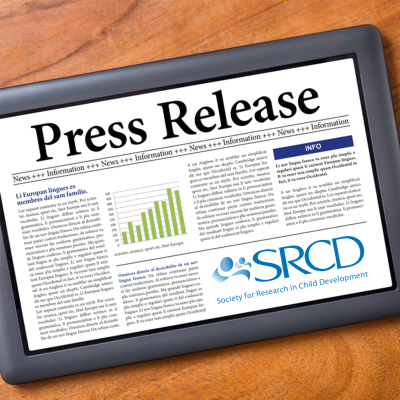Research Shows Young Infants Use their Mother’s Scent to See Faces
PRESS RELEASE / CHILD DEVELOPMENT: Embargoed for Release on July 18, 2024.
Q&A with Child Development Author
Humans see the world through the five senses, but how and when the ability to integrate across the senses arises is debated. Research shows that humans combine sensory information together, particularly when one sense is not able to produce a sufficient response alone. Studies also show that infants may use multisensory cues to perceive their environments more efficiently. A new Child Development study by researchers at the Université de Bourgogne, University of Hamburg, Université de Lyon, Institut Universitaire de France, Université de Lorraine, Centre Hospitalier de Nancy, and Centre National de la Recherche Scientifique (CNRS) tracked how and when French infants aged between four and 12 months, use their mother’s scent to perceive faces.
Results helped researchers confirm that the ability to perceive faces greatly improves between four and 12 months with younger infants benefitting the most from the presence of their mother’s odor. The research also suggests that older infants efficiently perceive faces from visual information, and they do not need to rely on other concurrent cues anymore.
The Society for Research in Child Development had the opportunity to discuss these findings with Dr. Arnaud Leleu, Associate Professor of psychology and neuroscience and Head of the Development of Olfactory Communication & Cognition (DOCC) Lab, Center for Taste, Smell and Feeding Sciences (CSGA) at the Université de Bourgogne in Dijon, France.
SRCD: What led you to study infants’ multisensory cues – in particular their sense of smell?
Dr. Leleu: I have a longstanding interest in how sensory perception works in the human brain. Despite its apparent simplicity (e.g., we open our eyes to see), perception is a complex neurocognitive ability derived from past experience with various stimulations coming from all the senses at the same time. Therefore, delineating how multisensory inputs are treated by the young infant brain is critical to understand perception in the different senses and its development until adulthood. In addition, research on multisensory perception is mainly focused on audition and vision, the “dominant” senses in humans compared to olfaction, which has long been held as poorly functional in our species. However, accumulating evidence indicates that the sense of smell is particularly functional in human infants, whereas other senses such as vision are largely immature. This is why a main purpose of my research is to determine whether and how olfaction fosters and shapes the development of visual perception in the infant brain.
SRCD: Can you please provide a brief overview of the study?
Dr. Leleu: In previous studies, we already showed that the rapid perception of faces, which are highly relevant visual inputs for infants, is shaped by another highly salient sensory signal for them, the mother’s body odor. To do that, we relied on electroencephalography (EEG) and measured a face-selective neural response that is enhanced by the presence of the mother’s odor in the 4-month-old brain. Here, our aim was to determine whether this olfactory-to-visual facilitation declines gradually as infants grow and become more efficient at perceiving faces solely from visual information, as previously shown for other associations between two senses. We tested 50 infants aged from 4 to 12 months, and found that the face-selective EEG response increases and complexifies between 4 and 12 months, indicative of improved face perception with development. As expected, we also found that the benefit of adding the mother’s body odor diminishes with age, confirming an inverse relation between the effectiveness of visual perception and its sensitivity to a concurrent odor. Overall, this demonstrates that visual perception actively relies on odor cues in developing infants until the visual system becomes effective by itself.
SRCD: How can these findings be useful for parents, pediatricians, and caregivers of young infants?
Dr. Leleu: Together with the large body of research on multisensory perception in infants, our findings reveal the importance of the early exposure to concurrent sensory inputs from different modalities for perceptual learning. Such early exposure to repeated intersensory associations is also a building block for the later development of higher-level abilities such as semantic memory, language and conceptual reasoning. It is therefore important to expose infants to a variety of cues related to the same objects as early as possible. For instance, infants would learn better what an apple is by seeing its shape and color, hearing the sound it makes when taking a bite of it, smelling its odor, touching its shape and texture. Moreover, given that our findings highlight the importance of the sense of smell in this early concert of the senses, every sensory modality should be considered when stimulating young infants, not only hearing and vision.
SRCD: Was there anything that surprised you?
Dr. Leleu: What surprised me the most, not only in these studies but also in the previous studies we conducted, is the fact that the mother’s odor has such a strong effect on the perception of various unfamiliar faces. Of course, we should further investigate the effect of other odors, but interestingly, recent studies from other groups confirmed the special status of the mother’s odor in infants by showing reduced reactions to fearful faces, higher attention toward an unfamiliar woman, and increased interbrain synchrony between the infant and that woman. Thus, it seems like the mother’s body odor reassures the infant and promotes their interest when they encounter novel people. In other words, this primary social odor that infants learn already in the womb seems to encourage prosocial cognitions and behaviors.
SRCD: What’s next in this field of research?
Dr. Leleu: Despite our recent efforts on this topic, the role of the sense of smell in the early development of multisensory perception remains poorly understood. Is the odor effect we observed specific to social stimuli or does it apply to any kind of stimuli? Which novel olfactory-visual associations emerge during development as long as the infants’ sensory environment changes (e.g., when infants start crawling and then walking)? Do odors evoke memories early on, as generally reported in adults (the famous “Proust phenomenon”)? Is that related to their strong emotional value? Much remains to be done and we are confident that our work will pave the way for future studies.
Funding for this research was supported by the French “Investissements d’Avenir” Program, Project ISITE-BFC; the “Conseil Régional Bourgogne Franche-Comté;” the European Funding for Regional Economic Development (FEDER); Agence Nationale de la Recherche; the European Research Council; and the Alexander von Humboldt Foundation.
Summarized from an article in Child Development, “Olfactory-to-visual facilitation in the infant brain declines gradually from 4 to 12 months” by Rekow, D., (Université de Bourgogne and University of Hamburg), Baudouin, J.Y., (Université de Lyon and Institut Universitaire de France), Kiseleva, A., (Université de Bourgogne), Rossion, B., (Université de Lorraine, CNRS and CHRU-Nancy), Durand, K., Schaal, B., and Leleu, A., (Université de Bourgogne and CNRS). Copyright 2024 The Society for Research in Child Development. All rights reserved.


